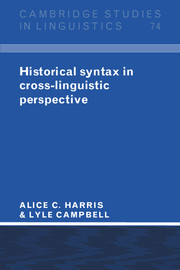Book contents
- Frontmatter
- Contents
- Preface
- List of abbreviations
- 1 Introduction
- 2 The history of historical syntax: major themes
- 3 Overview of a theory of syntactic change
- 4 Reanalysis
- 5 Extension
- 6 Language contact and syntactic borrowing
- 7 Processes that simplify biclausal structures
- 8 Word order
- 9 Alignment
- 10 On the development of complex constructions
- 11 The nature of syntactic change and the issue of causation
- 12 Reconstruction of syntax
- Appendix
- Notes
- References
- Index of languages and language families
- Index of scholars
- Index of subjects
4 - Reanalysis
Published online by Cambridge University Press: 05 June 2012
- Frontmatter
- Contents
- Preface
- List of abbreviations
- 1 Introduction
- 2 The history of historical syntax: major themes
- 3 Overview of a theory of syntactic change
- 4 Reanalysis
- 5 Extension
- 6 Language contact and syntactic borrowing
- 7 Processes that simplify biclausal structures
- 8 Word order
- 9 Alignment
- 10 On the development of complex constructions
- 11 The nature of syntactic change and the issue of causation
- 12 Reconstruction of syntax
- Appendix
- Notes
- References
- Index of languages and language families
- Index of scholars
- Index of subjects
Summary
Introduction
In this chapter we define reanalysis, provide a number of examples in order to convey some understanding of the variety in and limits on this mechanism, and show in detail how reanalysis works. We investigate its relation to grammaticalization and actualization, and we show how it fits in our overall view of grammar change. Reanalysis has been the most important concept for most attempts to explain syntactic change throughout the history of linguistics and especially in the last thirty years or so (see chapter 2). Langacker (1977a: 57) might well be speaking for the field in general when he says: “not all diachronic developments in the domain of syntax involve reanalysis … but this is clearly a major mechanism of syntactic evolution which we must understand in depth if we wish to understand how and why syntactic change occurs.” It is also of central importance in our approach, and we attempt here to define it rigorously and characterize it in detail.
Reanalysis, as defined in chapter 3, is a mechanism which changes the underlying structure of a syntactic pattern and which does not involve any immediate or intrinsic modification of its surface manifestation. This definition is intended to isolate one part of a process for further discussion; it is not intended as a claim that changes involving reanalysis cannot additionally involve some modification of surface manifestation (though such modifications necessarily involve mechanisms other than reanalysis).
- Type
- Chapter
- Information
- Historical Syntax in Cross-Linguistic Perspective , pp. 61 - 96Publisher: Cambridge University PressPrint publication year: 1995

